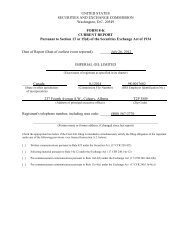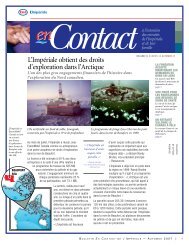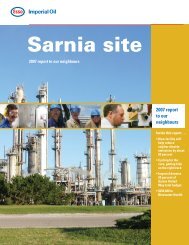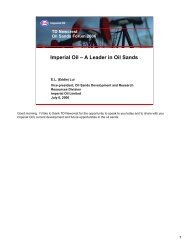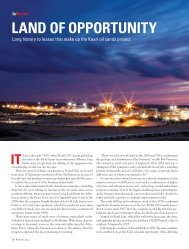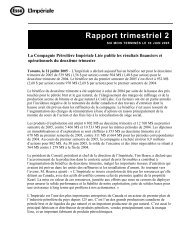FORM 10-K IMPERIAL OIL LIMITED
FORM 10-K IMPERIAL OIL LIMITED
FORM 10-K IMPERIAL OIL LIMITED
Create successful ePaper yourself
Turn your PDF publications into a flip-book with our unique Google optimized e-Paper software.
Assumptions<br />
Other post-retirement<br />
Pension benefits<br />
benefits<br />
millions of dollars 2004 2003 2002 2004 2003 2002<br />
Assumptions used to determine benefit obligations at December 31 ( p e rc e n t )<br />
Discount rate 5.75 6.25 5.75 6.25<br />
Long-term rate of compensation increase 3.50 3.50 3.50 3.50<br />
Assumptions used to determine net benefit cost for years<br />
ended December 31 ( p e rc e n t )<br />
Discount rate 6.25 6.25 6.75 6.25 6.25 6.75<br />
Long-term rate of compensation increase 3.50 3.50 3.50 3.50 3.50 3.50<br />
Long-term rate of return on funded assets 8.25 8.25 8.25 – – –<br />
(a) A summary of net benefit costs with elements of employee future benefit cost before and after adjustments to recognize the long-term nature of<br />
employee benefit cost is shown in the table below:<br />
Pension benefits<br />
Other post-retirement benefits<br />
millions of dollars 2004 2003 2002 2004 2003 2002<br />
Components of net benefit cost:<br />
Current service cost 76 71 64 6 5 4<br />
Interest cost 237 219 222 24 22 21<br />
Actual return on plan assets (315) (377) <strong>10</strong>7 – – –<br />
Plan amendments for prior service 37 – 27 – – –<br />
Actuarial loss/(gain) 405 171 196 47 19 25<br />
Elements of employee future benefit costs before<br />
adjustments to recognize the long-term nature of<br />
employee future benefit costs 440 84 616 77 46 50<br />
Adjustments to recognize the long-term natur e<br />
of employee future benefit costs:<br />
Difference between expected return and actual return<br />
on plan assets for the year 92 198 (298) – – –<br />
Difference between amortization of prior service costs<br />
for the year and actual plan amendments for the year (<strong>10</strong>) 25 (2) – – –<br />
Difference between actuarial (gain)/loss recognized<br />
for the year and actuarial (gain)/loss on accrued benefit<br />
obligation for the year (337) (<strong>10</strong>2) (162) (43) (16) (24)<br />
Net benefit cost 185 205 154 34 30 26<br />
(b) U n re c o rded assets/(liabilities) are amortized over the average remaining service life of employees, which for 2005 and subsequent years is 13 years<br />
(2004 – 13 years; 2003 – 13.5 years).<br />
Plan assets<br />
The company’s pension plan asset allocation at December 31, 2003 and 2004, and target allocation for 2005 are as follows:<br />
Target Percentage of plan assets<br />
allocation at December 31<br />
Asset category ( p e rc e n t ) 2005 2004 2003<br />
Equities 50 – 75 62 62<br />
Bonds 25 – 50 38 38<br />
Other 0 – <strong>10</strong> – –<br />
Total <strong>10</strong>0 <strong>10</strong>0<br />
The company establishes the long-term expected rate of return by developing a forward-looking long-term return assumption for each<br />
asset class, taking into account factors such as the expected real return for the specific asset class and inflation. A single, long-term<br />
rate of return is then calculated as the weighted average of the target asset allocation and the long-term return assumption for each<br />
asset class. The 2004 long-term expected return of 8.25 percent used in the calculations of pension expense compares to an actual rate<br />
of return over the past decade of <strong>10</strong>.7 percent.<br />
The company’s investment strategy for benefit plan assets reflects a long-term view, a careful assessment of the risks inherent in various<br />
asset classes and broad diversification to reduce the risk of the total portfolio. The company primarily invests in funds that follow an<br />
index-based strategy to achieve its objectives of diversifying risk while minimizing costs. The fund holds Imperial Oil Limited common<br />
s h a res only to the extent necessary to replicate the relevant equity index. Asset-liability studies, or simulations of the interaction of cash<br />
flows associated with both assets and liabilities, are periodically used to establish the pre f e rred target asset allocation. The target asset<br />
allocation for equity securities reflects the long-term nature of the liability. The balance of the fund is targeted to debt securities.<br />
F-14



